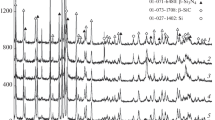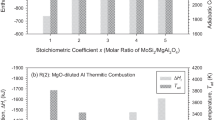Abstract
In the work, the preparation of fine-grained silicon was performed in combustion mode by magnesiothermic reduction of silica, obtained from serpentine mineral, which is characterized by a high specific surface area (about 560 m2/g) and high reaction activity. It is manifested by the fact that the measured combustion temperature exceeded the adiabatic combustion temperature calculated with the ISMAN THERMO software, by about 200 °C. In order to mitigate the synthesis conditions, combustion products (Si+2MgO) were used as diluting agents allowing a significant decrease of combustion temperature and a finer silicon powder without contaminating the target product with incidental reagents and without decreasing the yield of the target product. Based on the measured values of combustion parameters (combustion temperature and combustion wave propagation velocity) vs diluent amount, it was estimated that the effective activation energy for SiO2+2Mg reaction by the solid+liquid mechanism in the temperature interval 1400–2100 °C was about 65±3 kJ/mol.
Similar content being viewed by others
References
Siffert P, Krimmel EF (2004) Evolution and future of a technology. Silicon. https://doi.org/10.1007/978-3-662-09897-4
Jacob DT (2015) There is no silicon-based life in the solar system. Silicon. https://doi.org/10.1007/s12633-014-9270-7
Sommers MA (2007) Silicon (understanding the elements of the periodic table). The Rosen Publishing Group, New York
Ekaphan S, Supaluck S, Pornthip A (2004) Preparation of ailicon from rice hulls. Techn Digest Int PVSEC 14:301–302
Onojah A, Amah AN, Ayomanor BO (2012) Comparative studies of silicon from rice husk ash and natural quartz. Am J Sci Ind Res:146–149
Bruel M (1995) Silicon on insulator material technology. Electronics Letters:1201–1202
Brook MA (2000) Silicon in organic, organometallic and polymer chemistry. Wiley, New York
Terekhov VA, Kashkarov VM, Turishchev SYu, Pankov KN, Volodin VA, Efremov MD, Marin DV, Cherkov AG, Goryainov SV, Korchagin AI, Cherepkov VV, Lavrukhin AV, Fadeev SN, Salimov RA, Bardakhanov SP (2008) Structure and optical properties of silicon nanopowders. Mater Sci Eng:222–225
Merzhanov AG, Mukasyan AS (2007) Combustion of solid flame. Tonus Press, Moscow
Munir ZA, Anselmi-Tamburini U (1989) Self-propagating exothermic synthesis of high temperature materials by combustion. Mater Sci Rep 3:277–365
Moore JJ, Feng HJ (1995) Combustion synthesis of advanced materials. Prog Mater Sci 39:243–273
Varma A, Rogachev AS, Mukasyan AS, Hwang S (1998) Combustion synthesis of advanced materials: principles and applications. Advances in Chemical Engineering:79–226
Grigorieva TF, Letsko AI, Talako TL, Vorsina IA, Udalova TA, Vosmerikov V, Vityaz PA, Lyakhov NZ (2012) Investigation of the process and products of the MASHS interaction of silicon dioxide with magnesium reparation in the carbon-free method for obtaining silicon. In: Proceedings of the Intern, pp 107–115
Lui Q, Tang H, Fang H (2012) Upgrade silicon powder prepared by SHS with acid leaching treatment. Advanced Materials Research:312–315
Yermekova Z h, Mansurov Z, Mukasyan AS (2010) Combustion Synthesis of Silicon Nanopowders. Intern J SHS:94–101
Abovyan LS, Kharatyan SL (2008) Production of silicon powder in the combustion mode. In: Proceedings of the international conference modern problems of chemical physics, pp 124– 125
Meekins BH, Lin YCh, Manser JS, Manukyan KhV, Mukasyan AS, Kamat PV, McGinn PJ (2013) Photoactive porous silicon nanopowder. ACS Appl Mater:2943–2951
Shiryaev A (1995) Thermodynamic of SHS processes: An advanced approach. Intern J of SHS:351–362
Zakaryan M, Aydinyan S, Zulumyan N, Kharatyan S (2014) Magnesiothermic reduction of silica’s of various origin and preparation of silicon. In: 4th International conference of young scientists - CHEMISTRY TODAY - 2014: pp 146–148
Zulumyan NO, Isahakyan AR, Pirumyan PA, Beglaryan AA (2010) The structural characteristics of amorphous silica. J Phys Chem:791–793
Khaykin BI, Merzhanov AG (1966) The theory of thermal front propagation of chemical reaction. Combust Explosion 2(3): 36–46
Author information
Authors and Affiliations
Corresponding author
Rights and permissions
About this article
Cite this article
Zakaryan, M.K., Aydinyan, S.V. & Kharatyan, S.L. Preparation of Fine-grained Silicon from Serpentine Mineral by Magnesiothermic Reduction of Silica in the Presence of Reaction Products as Diluents. Silicon 9, 841–846 (2017). https://doi.org/10.1007/s12633-017-9583-4
Received:
Accepted:
Published:
Issue Date:
DOI: https://doi.org/10.1007/s12633-017-9583-4




